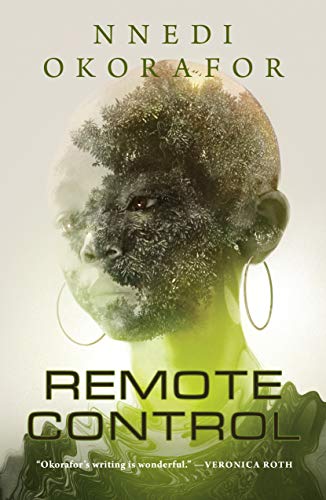From the brilliant opening of Nnedi Okorafor’s Remote Control, when we meet the confident Sankofa, just fourteen, walking a road in rural Ghana (“Small swift steps made with small swift feet”) the hints of her extraordinary power are everywhere. She is a subject of rumor, people hide from her approach, she wears adult clothes though she has the frame of a ten year-old, a strange species of red fox follows her everywhere, and she knocks on the door of a wealthy family’s house, saying “Death has come to visit.”
I was completely captivated by this short novel from that masterful opening to its last sentence, but, as Okorafor describes Remote Control, there is a much broader context to this and most of her other books. She says that this is a prequel to a prequel, and that the three books were written backwards in time. First, she wrote Who Fears Death, then to explore the origins of that world, wrote The Book of Phoenix. Remote Control is the closest to our own time, set a few decades from now. And before those three books, she wrote the Binti series, in which Africans go to the stars in a far future. So as far as time and generations go, she wrote them in reverse order. There are ideas and themes connecting them all, and they are suffused with Okorafor’s concept of Africanfuturism. Here’s a brief part of her explanation of that idea – please read her full blog post to get a better understanding of what it is and why she felt compelled to create this approach to science fiction:
Africanfuturism is concerned with visions of the future, is interested in technology, leaves the earth, skews optimistic, is centered on and predominantly written by people of African descent (black people) and it is rooted first and foremost in Africa. It’s less concerned with “what could have been” and more concerned with “what is and can/will be”. It acknowledges, grapples with and carries “what has been”.
Nnedi’s Wahala Zone Blog: African Futurism Defined
Remote Control is a wonderful blend of legend, myth, a portrait of near future Ghana, a young girl’s coming of age, the impact of technology, the long reach of corporate control and the arrival of alien artifacts and power. It works for me on so many levels. Perhaps the most moving is the story of a five year-old girl, whose world is destroyed through no fault of her own and who must strike out by herself and learn to live as an outcast.
A power she absorbed through contact with an alien artifact gives her the stunning ability to emit a glow that kills people around her. Before she learns to control that power, she has inadvertently taken the lives of many who are close to her, leaving her truly alone. And when she touches any technology, like a drone or a self-driving car, it immediately breaks. So her only way to get around is by walking, and walk she must to track down the artifact that has been stolen from her. She follows its movements not because she wants to get it back but simply because it calls to her and lets her know through an inner GPS where it is.
She finds respite from that endless long walk in a few places where she can live with a friend or by herself in the forest, but those restorative interludes are always cut short, sometimes brutally.
After the search for the artifact comes to an end, she has another goal, to return to the hometown and the house she left behind after the first catastrophe she lived through. So it’s also a moving story of coming home, for someone who has lost everything that made that place the welcoming center of her childhood.
When I started reading Remote Control, I recalled something the late Tewa anthropologist, Alfonso Ortiz, told me about his travels in Mexico. He would often see a lone elder walking along a remote road, and he wondered where that indigenous person might be coming from and where they might be headed. It made him think of all the fractured native cultures that had survived the long history of conquest, slavery, forced assimilation, ongoing discrimination and technological change. There were so many individuals forced out of their traditional ways of life, forced to wander, but where could they go?
The girl Sankofa, the adopted daughter of Death, gains power to resist the corporate controlled technologies taking hold in her native Ghana, but we are left at the end with a sense of the immensity of the task she would face. But this is not a story of rebellion, it is a story of survival, of coming to terms with a terribly broken life, of learning to master the power that is more burden than gift.
I find Remote Control incredibly moving and beautiful, and it pushes me to read The Book of Phoenix and Who Fears Death and to reread the Binti series. Okorafor’s Africa is a dazzling world, and this story of a young girl empowered in a dangerous and costly way is one of her best.





Leave a Reply